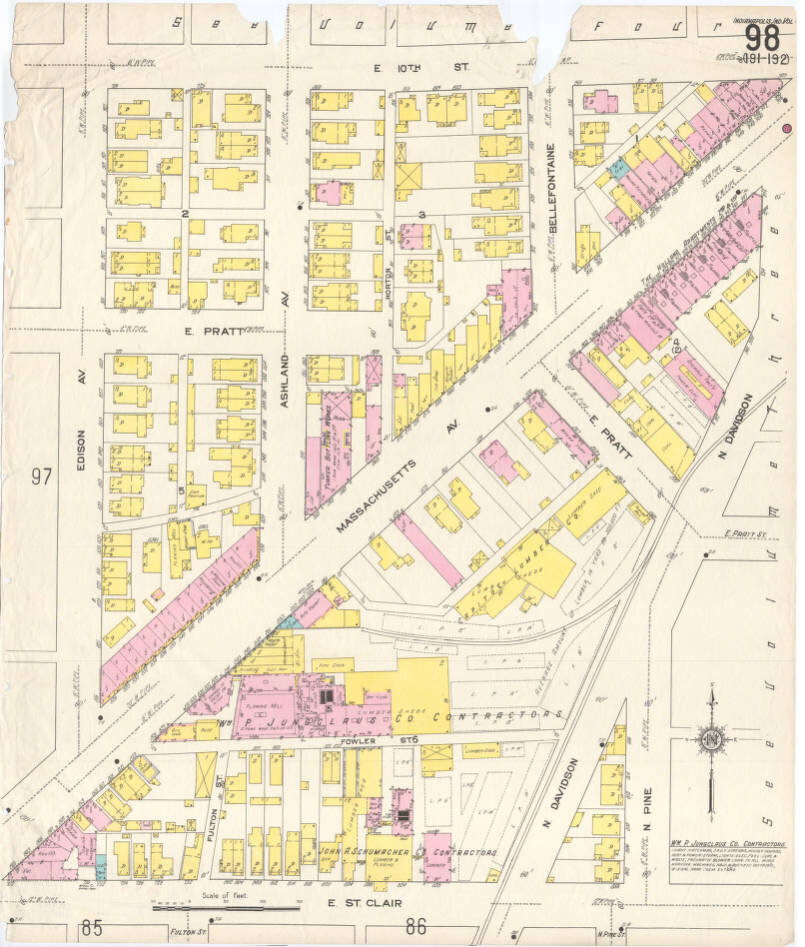History of the Jungclaus Mill
1875
William P. Jungclaus, founder
William Peter Jungclaus, a sea captain from Germany, partners with cousin John Albert Schumacher to form Jungclaus & Schumacher, Contractors & Builders.
Their planing mill and lumberyard was located on East St. Clair St., where the Mayflower building currently stands.
1895
(above) Wm. P. Jungclaus & Son acquired the Capitol City Planing Mill at 825 Massachussetts Avenue
Now “the foremost contractors” in Indianapolis, “Bill” Jungclaus and “Al” Schumacher each have two sons in the business. Schumacher proposes to dissolve their partnership for “each of them to give their boys a chance.”
They agree that Schumacher will keep the plant and Jungclaus will assume the outstanding contracts, which will keep him busy for three months.
Jungclaus establishes Wm. P. Jungclaus & Son (later known as the Wm. P. Jungclaus Co., and presently, Jungclaus-Campbell Co., Inc.).
Shortly thereafter, he buys the Capitol City Planing Mill, which had been established shortly after the Civil War, and is located right around the corner on Massachusetts Avenue.
The Capitol City office, built in 1865, still stands today at 825 Massachusetts Avenue, and continues to serve as Jungclaus-Campbell’s main office.
September 23, 1920
A devasting fire—one of several in the area that night—destroys the barn, four-story mill, and storage house of the William P. Jungclaus Co. The September 24, 1920 Indianapolis Times reported the fire causes $85,000 in damage to the Jungclaus properties, and that it was the “opinion of firemen that it was the work of an incendiary or had started from sparks from a railroad engine.”
A subsequent article in that issue of the Times describes a witness seeing a man “wearing a dark suit of clothes and a soft felt hat” fleeing the scene of one fire and running towards the rear of Jungclaus factory. “It is believed that he … started that fire,” reported the Times.
William P.’s son, Frederick W., Treasurer of the company, told the newspaper that the losses were considerable but covered by insurance and he vows to rebuild.
1920 - 1950
The William P. Jungclaus Co. completed the Columbia Club building in 1925
The William P. Jungclaus Co. builds and furnishes millwork—including cabinetry, trim, windows, and doors—for many of the most prominent landmarks in Indianapolis, including the Indiana Theater (1924), the Columbia Club (1925), the Circle Tower (1929), and the Coca-Cola Bottling Plant (1930).
Interior office suite, Coca-Cola Bottling Plant
1951
Meridian Street Methodist Church is built. The swan song of the old, German-speaking craftsmen and their pre-World War II machinery, this would be the last large project to leave the Jungclaus mill.
1959
Nancy Barton and her brother Bob shared this footage that their father, Jim Barton, took of the Wm. P. Jungclaus Co.
1967
Bill Campbell, husband of William H. Jungclaus’s daughter Barbara, purchases the properties and construction company, now named Jungclaus-Campbell.
The woodworking operation, throughout the 1960s employing just one man, is shuttered and the mill buildings function as warehouses. Jungclaus-Campbell turns its focus to the Industrial and Educational markets.
1990
Tim Nagler acquires the construction company from Bill Campbell, his father in law.
2014
Tim Nagler acquires the Jungclaus properties from the Campbell family. He undertakes numerous projects restoring the timber-frame and brick buildings until his death in 2020.
2021
The decision is made to name our mixed-use campus the Jungclaus Mill.
The guiding principle continues to be the preservation and restoration of the historic character of our buildings and campus.
Jungclaus-Campbell has been the anchor of the properties since 1895.












